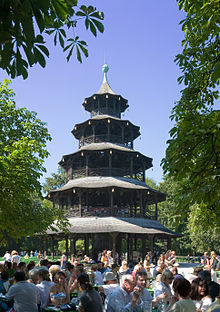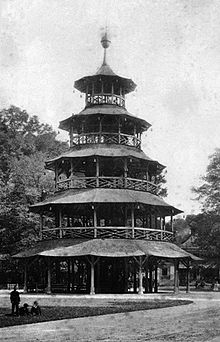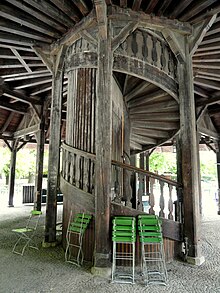Chinese Tower (Munich)
The Chinese Tower , also known as China Tower and at the beginning as Great Pagoda known is a 25 meter high timber in the style of a pagoda , which in the English Garden in Munich stands. The structure was built between 1789 and 1790 and opened to the public as a viewing platform in 1792 with the opening of the English Garden . The Chinese Tower burned down during one of the air raids on Munich during World War II , but was reopened in 1952 after reconstruction . The tower is now a landmark of the English Garden.
In the 1970s, the building was closed for security reasons and since then has only been allowed to be entered by the brass bands that regularly play there. At the Chinese Tower there is a carousel from the Biedermeier period, which has now also been reconstructed, and numerous restaurants. Every third Sunday in July, the so-called Kocherlball , an event revived in 1989, is celebrated at the Chinese Tower.
Location and connection
The Chinese Tower is located in the southern part of the English Garden in the Schwabing district . The building is located north of the Monopteros and the utility building and a few meters east of the Oberstjägermeisterbach . The Rumford House is located to the east of the tower construction .
The Chinese Tower can be reached by public transport operated by the Munich Transport Company. Public buses stop in the immediate vicinity at the Chinesischer Turm stop , the stopping area of which can only be used by public transport and cyclists. The tower can also be reached by tram from the Tivolistraße stop . From there there is also a connection to the bus lines that continue to the Chinesischer Turm stop. The next underground station is Giselastraße , a station on which two lines of the trunk line 1 run. From there, it is also a ten-minute walk through the English Garden.
history
In the years 1789 and 1790 the Chinese Tower was built by Johann Baptist Lechner according to a design by Joseph Frey as part of the planned public park, today's English Garden. The construction was carried out by Johann Baptist Erlacher and Martin Heilmayr, two court carpenters with local roots. During these years the Chinese architectural style was fashionable in Europe , so Benjamin Thompson , who was in charge of the creation of the English Garden, endorsed the construction in the as yet unopened Volkspark or even suggested the construction. The model was the around 50 meter high pagoda in London's Royal Botanic Gardens , which in turn is a replica of the majolica pagoda in Beijing . Two years after the completion of the “great pagoda”, as the Chinese Tower was called at the beginning, the first courtyard festival in the English Garden, then known as “Theodors Park”, was celebrated near the tower. In the same year the park and with it the Chinese tower was opened to the public; previously the area had been the hunting district of the Wittelsbachers .
At the beginning, the tower structure served primarily as a viewing platform. According to tradition, the surrounding trees were no higher than the second floor at the time of construction. In the meantime, many trees tower above the wooden structure, so that it is no longer suitable as a viewing platform. However, the nearby restaurants gave the building its current popularity and, according to the author Daniela Dau, developed into the "heart of the English Garden".
Friedrich Ludwig Sckell , who from 1804 managed the court gardens in Bavaria and thus also the English Garden, presented a redesign of the English Garden in 1807 in which he wanted to have the Chinese tower already built demolished. Instead, as a style purist , he wanted to avoid large architectural staffages and limit the park to a few, simple, classicist buildings. According to him, “the Chinese taste of architecture deserves no imitation”. However, he was unable to implement his plan.
The Chinese tower was often damaged by fire, but it was always repaired. On July 13, 1944, towards the end of World War II , the tower construction burned down when a phosphorus bomb was dropped . The faithful reconstruction took place from 1951 to 1952 by the architect Franz Zell and the ceremonial handover of the rebuilt building took place on September 6th of the same year. Since then, the construction has been considered the "landmark of the English Garden". In 1960 the tower was opened to the public again. Since the 1970s, however, guests have not been allowed to enter for security reasons; only the brass bands playing there are allowed to climb. Only rarely, as on September 6, 2002, on the occasion of the 50th anniversary of the reconstruction, are tower ascents offered for up to 15 people with a guided tour.
In 2002, one of two WiFi hotspots was set up in the Chinese Tower in the English Garden. It served successfully as a Germany-wide pilot of such an offer.
architecture
The wooden Chinese tower is said to be reminiscent of a Chinese temple in the style of a pagoda. The building is 25 meters high and has five floors with the ground floor. Like a fir tree, the diameter of the polygonal structure, which is attached to each corner with a column, becomes narrower per floor. Shingle roofs are attached to the outside of each floor . Gilded bells hang on the corners further inside. In the middle of the building there is a spiral staircase connecting the floors. Additional wooden beams were attached under the floor on each floor from the first floor. The maximum diameter of the Chinese tower is about 19 meters, the minimum diameter of a floor is 6 meters.
Alongside the Rumford House and the Monopteros , the Chinese Tower is now one of three “atmospheric architectures” in the Volkspark.
carousel
The first children's carousel near the Chinese Tower was built in 1823, but it no longer exists. Since 1913 there has been a carousel for children with carved wooden animal figures ( deer , ibex , camel , giraffe , horse , stork and flamingo ) or with old-fashioned carriages, wagons and sleds. Since then, the carousel with Biedermeier figures has been making its rounds to barrel organ and polyphonic music. The animal figures with the objects are distributed on an inner and outer circle. In addition to the carousel, there is also a playground for the children. The carousel was conceived, made and painted by the sculptor Joseph Erlacher and the decorative painter August Julier . Like the Chinese Tower and the English Garden, it has belonged to the Bavarian Palace Administration since 1977 .
Events
Regular and irregular public events are held at the Chinese Tower.
For the Kocherlball on the third Sunday of July at 6:00 a.m., numerous women and men in traditional costumes meet at the Chinese Tower to dance folk dances and waltzes to music. The event is named after a custom of the cooks, maids and servants who meet to dance every Sunday in the summer before work starts at the Chinese Tower. The ball was created around 1880 and around 5,000 people attended the event at that time. In 1904 the Kocherlball was banned by the police for "lack of morality". In 1989, as part of the 200th anniversary of the English Garden, the tradition was revived; However, since then the tradition has only been celebrated on one Sunday a year. In the first year of the revived Kocherlball, around 15,000 people were involved. In the following years the number leveled off at mostly over 10,000 guests. For example, there were around 12,000 visitors each in 2002 and 2013 and around 15,000 guests came to the 16th new edition. In 2014 the tradition to celebrate the 100th anniversary of the Tölzer Kurhaus in Bad Tölz was taken up and a cookery ball was celebrated there too.
In addition to the Kocherlball, 21 other events were held at the Chinese Tower to mark the 200th anniversary of the English Garden. During the Christmas season there is an annual Christmas market at the Chinese Tower .
In summer, on Sundays and public holidays, brass music is played alternately by the Rossbachtaler and Thoma chapels on the first floor of the Chinese Tower . If the weather is good, the musicians will also play on Wednesday and Friday until early evening.
Gastronomy
During the Biedermeier period, from about 1825 to 1848, there was the Chinese economy south of the Chinese Tower , in which there was both a bowling alley and a dance floor . At that time beer was served in and around the Chinese Tower . Dance music was played three times a week and there were concerts or military bands. At the time of the Chinese economy, there were also four small wooden pavilions with characteristic curved roofs. In 1912 a new restaurant was built on this site .
Since 1974, the Chinese Tower has been home to a beer garden under the management of the landlady Antje Schneider, which, with 7,000 seats, is the second largest beer garden in Munich after the Hirschgarten . The beer garden, which serves Hofbräubier , is now a popular place for tourists. In keeping with Bavarian tradition , you can bring your own snack to the beer garden for consumption.
The restaurant at the Chinese Tower is located next to the beer garden . This offers regional and international cuisine. Court society often dined in the restaurant during the 19th century.
In art and literature
The Chinese Tower is often mentioned or depicted in art and literature in relation to the English Garden. In 1830 Moritz Gottlieb Saphir wrote a poem entitled The Chinese Tower about the hustle and bustle of people and nature on the building. Five years later, an enthusiastic letter from Bettina von Arnim to Johann Wolfgang von Goethe was published, in which she also writes about the "Chinese towers". In Breakfast with Brass Music in 1840, an anonymous author published a column in the Vaterländischer Magazin about the mood when eating at the tower structure.
As early as the 18th century, the Chinese Tower inspired numerous artists who included it as both a main and a secondary motif in pictures and drawings. Carl August Lebschée , Johann Michael Mettenleiter , Fritz Schider and Richard Mahn , among others , presented the building in different ways using various artistic means.
literature
- Daniela Dau: English Garden - On an adventure tour in Munich's leisure paradise . Volk Verlag, Munich 2011, ISBN 978-3-86222-021-2 .
- The English Garden in Munich . Alois Knürr Verlag, Munich 2000, ISBN 3-928432-29-X .
- Rüdiger Liedtke: 111 places in Munich that tell a story . Emons Verlag, Cologne 2013, ISBN 978-3-95451-221-8 .
- Rüdiger Liedtke: 111 places in Munich that you have to see . Emons Verlag, Cologne 2011, ISBN 978-3-89705-892-7 .
- Marianna Mehling, Brigittegler-Bellinger , Tamara Trautner: Knaur's cultural travel guide in color - Munich . Droemer Knaur, Augsburg 1998, ISBN 3-8289-0696-6 .
Web links
- Official website of the Chinese Tower restaurant
- Official website of the Christmas market
- 360 ° panorama
Individual evidence
- ↑ a b kre: Idyllic dining in the Chinese Tower restaurant. Münchner Merkur , accessed on December 15, 2015 .
- ↑ Beate Wild: Schwabing - The Montmartre of Munich. Süddeutsche Zeitung , January 25, 2010, accessed June 19, 2014 .
- ↑ Dau: Englischer Garten - On an adventure tour in Munich's leisure paradise. P. 3.
- ↑ Dau: Englischer Garten - On an adventure tour in Munich's leisure paradise. P. 5.
- ↑ a b c Beer garden guide: Chinese tower. (No longer available online.) Tz June 12, 2014, archived from the original on August 7, 2014 ; Retrieved June 19, 2014 . Info: The archive link was inserted automatically and has not yet been checked. Please check the original and archive link according to the instructions and then remove this notice.
- ↑ a b c d e f g h Liedtke: 111 places in Munich that tell a story. P. 46.
- ↑ a b c d e f g h i j Chinese tower. In: muenchen.de. Retrieved June 19, 2014 .
- ↑ Christl Karnehm: The English Garden in Munich. P. 114 (Buildings and monuments in the garden then and now from A – Z).
- ↑ a b c d e Liedtke: 111 places in Munich that you have to see. P. 104.
- ^ Pankraz Freiherr von Freyberg: The English Garden in Munich. P. 86 (Oldest description of the English Garden from May 30, 1790).
- ↑ a b c d e f g h i Dau: English Garden - On an adventure tour in Munich's leisure paradise. P. 4.
- ^ A b Mehling, Regulator-Bellinger, Trautner: Knaur's cultural travel guide in color - Munich. P. 182.
- ↑ Doronthea Lehner: The English Garden in Munich. P. 40.
- ^ A b c Christl Karnehm: The English Garden in Munich. P. 113 (Buildings and monuments in the garden then and now from A – Z).
- ^ Dorothea Lehner: The English Garden in Munich. P. 41 (The Fathers of the English Garden Friedrich Ludwig: Friedrich Ludwig von Sckell (1750–1823)).
- ^ A b Elfi Zuber : Munich - history, personalities, events . Institut Bavaricum, Munich 1993, p. 82 .
- ↑ Dau: Englischer Garten - On an adventure tour in Munich's leisure paradise. P. 13.
- ^ Klaus Gallas : Munich. From the Guelph foundation of Henry the Lion to the present: art, culture, history . DuMont, Cologne 1979, ISBN 3-7701-1094-3 , pp. 342 .
- ^ Mehling, Regulator-Bellinger, Trautner: Knaur's cultural travel guide in color - Munich. P. 185.
- ↑ a b c d 50 years of reconstruction of the Chinese Tower in the English Garden. (rtf) Bayerische Schlösserverwaltung, August 2002, p. 1 , accessed on June 23, 2014 .
- ^ Waldemar Palten, Karl-Friedrich Beuckelmann: The English Garden in Munich. P. 254.
- ↑ Dau: Englischer Garten - On an adventure tour in Munich's leisure paradise. P. 14.
- ↑ Ekkehard Müller-Jentsch: Anyone who can use WiFi. Süddeutsche Zeitung, June 13, 2003, accessed June 19, 2014 .
- ↑ The great ADAC city guide - Our most beautiful cities from Flensburg to Munich, from Aachen to Berlin . ADAC-Verlag, Munich 1990, ISBN 3-87003-357-6 , p. 580 .
- ↑ a b Restaurant at the Chinese Tower in Munich. muenchen.de, accessed on June 19, 2014 .
- ↑ a b blt: The Kocherlball. Süddeutsche Zeitung, May 11, 2010, accessed June 20, 2014 .
- ↑ Agnes Fazekas: Morals and Morality. In: Skurrile Stadt (2) - bragging knowledge for Munich residents. Süddeutsche Zeitung, November 27, 2008, accessed June 20, 2014 .
- ↑ a b Claudia Köstler: With swing in a circle. Süddeutsche Zeitung, June 15, 2014, accessed on June 20, 2014 .
- ↑ Kocherlball in Munich - Dance with me in the morning. Süddeutsche Zeitung, July 21, 2013, accessed June 20, 2014 .
- ↑ Sandra Müller: Dirndl turn and all around. Süddeutsche Zeitung, May 10, 2010, accessed on June 20, 2014 .
- ↑ The English Garden in Munich. P. 274 (Big celebrations in the English Garden).
- ↑ Chinese tower. (No longer available online.) In: Biergarten.com. Formerly in the original ; accessed on January 22, 2018 . ( Page no longer available , search in web archives ) Info: The link was automatically marked as defective. Please check the link according to the instructions and then remove this notice.
- ↑ Paradise under chestnuts . Manager Magazin, Hamburg May 23, 2012 ( article online [accessed June 21, 2014]).
- ↑ Susanne Popp: Why are visitors to Munich allowed to bring their snack to the beer garden? In: Questions from city life. Süddeutsche Zeitung, July 13, 2009, accessed June 19, 2014 .
- ↑ The English Garden in Munich. P. 167 (Literary walk through the English Garden, quoted from: Moritz Gottlieb Saphir, Der Chinesischer Thurm. 1830).
- ↑ The English Garden in Munich. P. 167 (literary walk through the English Garden, quoted from: Bettina von Arnim , Goethe's correspondence with a child, part 2 , Berlin 1835).
- ↑ The English Garden in Munich. P. 168 (Literary walk through the English Garden, quoted from: Breakfast with brass music. 1840).
- ↑ The English Garden in Munich. P. 51.
- ↑ The English Garden in Munich. Pp. 82-83, 87.
- ↑ The English Garden in Munich. P. 94.
- ↑ The English Garden in Munich. P. 161.
Coordinates: 48 ° 9 ′ 9 ″ N , 11 ° 35 ′ 31.6 ″ E



